|
|
|
October 21, 2020
The corn plot was harvested last Saturday. The overall plot average was 208.9
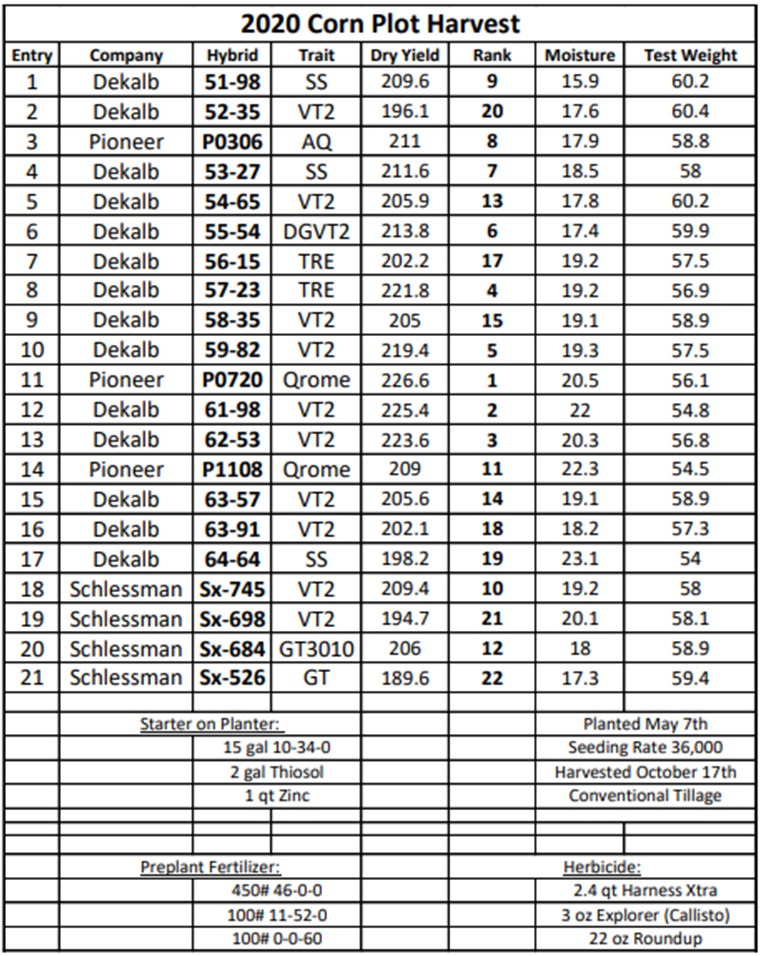
August 3, 2020
Wheat prices are available now and we are starting to take orders for wheat this fall. We carry Wellman's and Schlessman wheat.
June 27, 2020
A reminder that this Tuesday, June 30th, is the last day to spray dicamba on Xtend soybeans following the label. After that other alternative herbicides will need to be used, if needed.
June 12, 2020
Dicamba spraying in Ohio must be done by the end of June the Ohio Department of Agriculture announced Tuesday night. That means any Xtend soybeans cannot legally have Xtendimax (or any other labeled dicamba product) sprayed on them after June 30.
May 19, 2020
Fungicide/insecticide spraying on wheat will start to take place soon. We are starting to write up orders now to get ready to spray once the wheat crop is at least 50% head emergence.
May 14, 2020
We have dry and liquid fertilizer located at the Beaverdam location. The fertilizer is found beyond the grain bins in the back of the property. We will have extra seed there as well if you need any to finish up.
May 7, 2020
We have had great weather for spreading and spraying the last couple weeks. Give us a call to get your orders in when they are ready to be sprayed or spread.
April 17, 2020
There will be a new dicamba training webinar from 10:00 until noon on Tuesday, April 21 for anybody that still needs to renew their annual dicamba training. The link is at https://www.cvent.com/events/monsanto-provided-dicamba-application-requirements-training-webinar/registration-76f980ebfa834ca29c1b66e0a107c0d4.aspx?fqp=true&utm_source=ExactTarget&utm_medium=OwnedEmail&utm_campaign=SystemOverall_RRXtend&utm_content=Dicamba_webinar&hlk=GA4WAutm_sid=1990098987
and click to register for the training to make sure everyone is good to go this spring.
March 31, 2020
Yesterday the state moved the H2Ohio deadline back to the original date, TODAY, instead of June. Make sure if you haven't signed up yet and still need to- give the soil and water office a call today.
March 27, 2020
We are starting to get busy getting seed and chemical orders around and packaged together. When the nice weather returns we will be trying to ship seed and chemical orders. If you don't have anything lined up let us know.
March 16, 2020
Top Dressing wheat will be starting in the near future. Give us a call to get your orders wrote up for wheat.
February 26, 2020
On Wednesday, March 11 there will be a Fertilizer and Pesticide Re-certification meeting at OSU Lima- Student Services Building, (420 Campus Drive, Lima). Fert recert will be 5-6 pm costing $10 and Pest Recert will follow from 6-9 pm costing $30. Pre register calling 419-879-9108.
February 24, 2020
There will be an in person training for dicamba at the Howard Johnson Hotel (1920 Roschman Ave.) in Lima on March 12. It will be presented by Bayer starting at 9:00 in the morning until around 11:00. Dicamba training is REQUIRED annually for anybody handling or spraying XtendiMax, Engenia. FeXapan, or Tavium herbicides.
February 20, 2020
There is an online training for Enlist traits and Enlist herbicides located at https://www.enlist.com/en/enlist-360-training.html for anyone interested in going through the training module. Once clicking on the website you can scroll down to the bottom for general public training. Unlike dicamba training, which is mandatory, Enlist training is NOT mandatory. It is more to inform the public on how we have to handle the Enlist One herbicide and to make aware of the different rules that go with spraying it.
February 13, 2020
If you are still needing to take the annual mandatory dicamba training you can do it online at https://www.roundupreadyxtend.com/stewardship/Education/Pages/default.aspx . There will also be an event in Lima on March 12 if you would rather attend and ask questions in person. You can click on the link to find more information about the Lima meeting and pre register for the event, which is encouraged.
February 4, 2020
Allen County's Ag Outlook & Agronomy Day will be held tomorrow, Thursday, February 6th from 8:00-3:30 at the Fairgrounds. Weed control, weather, water quality, economics and much more will be talked about at this OSU Extension event.
January 24, 2020
Informational meetings about H2Ohio will be going on throughout our grower area in the month of February. Click here to open the file showing the dates, times, and locations for the meetings.
January 21, 2020
There is a good article about nutrients needed in corn production at this link from Dekalb/Asgrow: https://www.dekalbasgrowdeltapine.com/en-us/agronomy/corn-nutrition-101.html
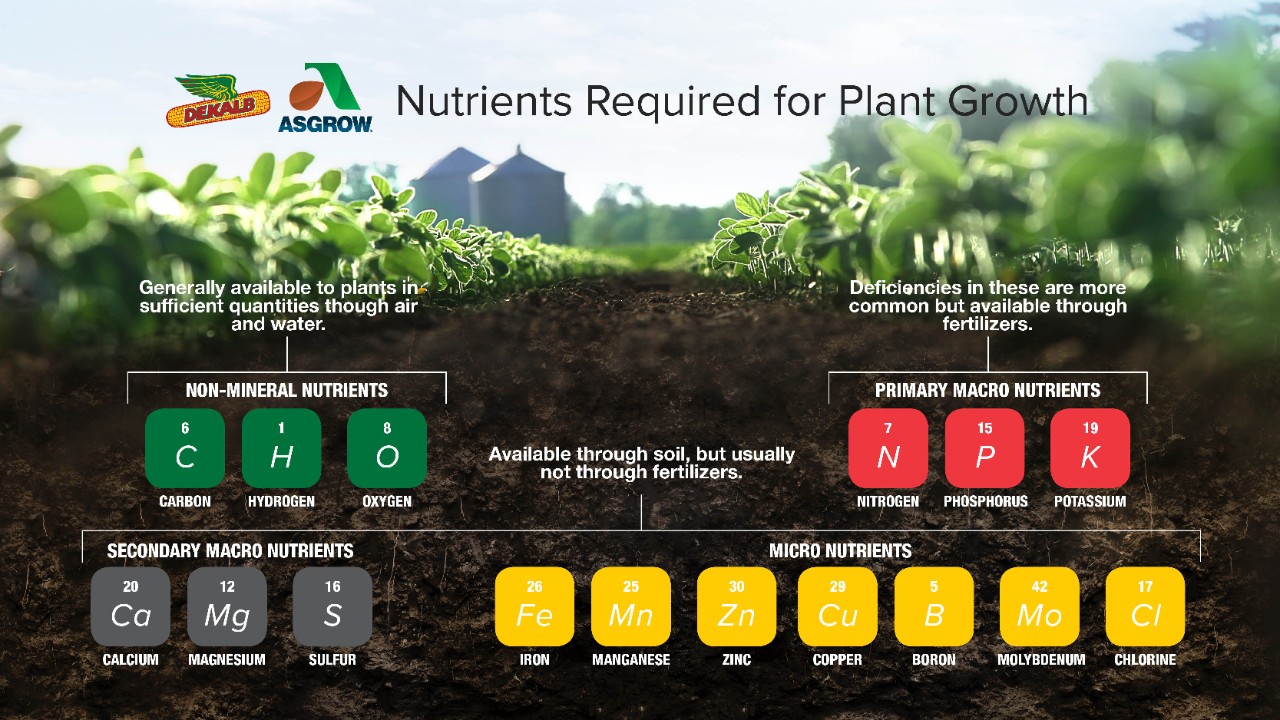
January 16, 2020
If you do not have a commercial or private fertilizer certificate and need to get one, there are two options. You can either sit through a three hour meeting or take a test through the ODA https://agri.ohio.gov/wps/portal/gov/oda/divisions/plant-health/pesticides/exam-registration,
which spots are filling quickly.
In this area there are two meeting locations- one in Lima and one in Bowling Green.
- February 20, 6-9 pm will be at the Wood County Fairgrounds Junior Fair Building. RSVP at (419) 354-9050
- April 1, 6-9 pm will be at OSU Lima Student Services Building. RSVP at (419) 879-9108
January 13, 2020
There will be two pesticide and fertilizer recertification events in Kalida in February at the Kalida Knights of Columbus (702 Napoleon Road, Kalida).
- Monday, February 3 from 8:00 am to 9:00 am will be fertilizer. 9:00 am until noon will be pesticide recertification.
- Monday, February 24 from 5:00 to 6:00 pm will be fertilizer. Then from 6:00 to 9:00 pm will be pesticide.
January 8, 2020
Mandatory dicamba training will be required for anybody spraying or handling dicamba (Xtendimax) this upcoming season. Roundupreadyxtend.com/onlinetraining is the website that you can go to to get credit instead of going to in person meetings this winter. There are also public meetings offered this year as well. Bayer has one scheduled already at the Howard Johnson Hotel in Lima on March 12th with the time TBA later.
January 3, 2020
A big Dekalb/Asgrow seed discount is coming up next Friday, January 10th. Make sure to place your order or get it paid before then for the best deal.
December 26, 2019
Happy holidays and have a great New Years!
We will be open normal hours (8-5) today, tomorrow and Monday. Tuesday, New Years Eve, we will be open until noon. Thursday, January 2, and the future we will be back to normal business hours of M-F 8-5.
December 6, 2019
Fulvic acid is the main delivery system to get nutrients in the plant even though it is not commonly talked about in the area for row crops. Most of the foliar fertilizers have fulvic acid already in them along with in furrow corn starter and other starter fertilizers. Fulvic acid plays a big role in plant uptake of nutrients.
December 4, 2019
Molybdenum (Mo) is a very trace element- less than 1 part per million (ppm) is in the soil and it is rare to see deficiency sypmtoms in the crop. Molybdenum is important to help the nodulation in soybeans and has a high crop response in alfalfa. Mo also converts nitrates in the soil to amino acids that the plant uses.
Keeping the soil pH correct (6.3-6.8) by liming does a big part in making Mo available. Our standard foliar fertilizer program also contains Molybdenum in it.
November 21, 2019
Zinc (Zn) is a micronutrient that shows up 71% of the time in our soil sample results as being deficient. Zinc is used in starter for corn and will also be sprayed foliar in both soybeans and corn.
Zinc promotes crop maturity, is key in growth hormones in the plant and is essential for early season growth. Zn also helps maintain plant health, helps with starch production and helps with mositure efficiency.
November 19, 2019
Manganese (Mn) is the next micronutrient that will be featured. It provides the plant energy for photosynthesis, helps it tolerate drought stress and helps uptake potassium among other important uses.
Soybeans and wheat require higher levels of Mn compared to some other crops. We usually put Manganese on with a foliar blend as it also helps the uptake of Roundup along with giving nutrients to the plant.
November 14, 2019
Boron (B) is a micronutrient that can get applied many different times throughout the year. We put boron on with fall fertilizer, can be on as a corn starter (not in furrow), and is foliar applied to corn and soybeans throughout the growing season. You do have to be careful to not put out too much on at one time.
Boron promotes early maturity, afffects pollination and flowering, affects the quality of the fruit/seed and is important in cell wall development. Low B levels can stunt root growth. On average in the last 5 years we see around 68% of samples come back deficient in B.
November 12, 2019
Sulfur (S) is an important secondary macronutrient that often gets overlooked. In the last three years around 46% of the soil tests that come back are deficient in Sulfur. We used to get Sulfur in the air from acid rain but now that power plants are cleaned up that is no longer the case. Sulfur is found in every living cell and is important to winter hardiness, photosynthesis, and necessary for nitrogen fixation in legume crops. It is tied to Nitrogen (N) where corn needs at least a 10:1 ratio of N to S.
To keep up Sulfur levels, fall is a good time to add elemental S to the fall fertilizer plans. You can also use Thiosol and 8-0-0-9 on corn starter and also 21-0-0-24S (AMS) in the dry form and Sulfur Plus as a foliar. Anytime you go across the field is a good time to put Sulfur out.
November 8, 2019
We are seeing a lot of purple deadnettle and marestail weeds and other winter annuals in fields. Fall is a good opportunity to get ahead of weed issues in the spring. We are using a dicamba/2, 4-D combination to kill weeds in the fall. It is never too late to get them killed.
November 4, 2019
The best discounts for Dekalb and Asgrow seed are happening now. Be sure to order yours soon to get the best prices!
November 1, 2019
Fall is still the best time to get dry fertilizer applied to fields for the next growing season. Prices are remaining lower than last year.
October 31, 2019
The Wurm nutritional and growth regulator soybean trial results came back after getting harvested. That mixture averaged 68.7 bushels per acre. Our standard foliar fertilizer mix averaged 64.0 bushels in that same field near Cairo.
October 17, 2019
Now is a good time to get your grid sampling work taken care of. If you've never done it before the first 50 acres will be free. Also, now is a good time to get fertilizer spread while the weather and fields are in good condition instead of waiting until the spring.
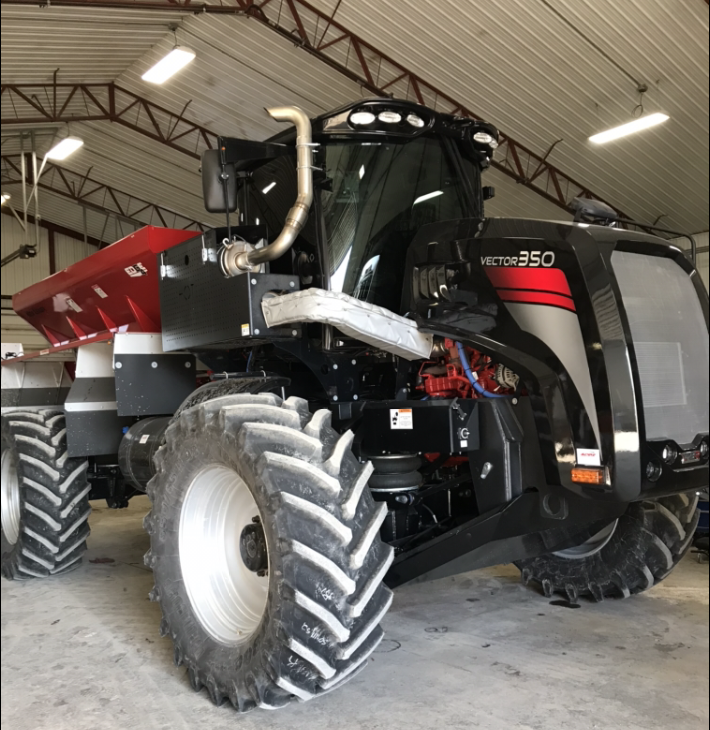
Be on the lookout for the brand new Vector spreader!
October 8, 2019
Soybeans are starting to come in to the elevators in the last week or so. Yields are looking better than expected- upper 50s to mid 60s. We expect corn to follow suit with decent yields.
As seen on the home page there is still seed wheat available for sale. We sell Schlessman and Wellman brand wheat this fall.
October 3, 2019
Year 2 of the nutrional and growth regulator trials has yielded a 15-20 bushel increase again this year over our standard foliar application. This side by side was done near Cairo, OH.
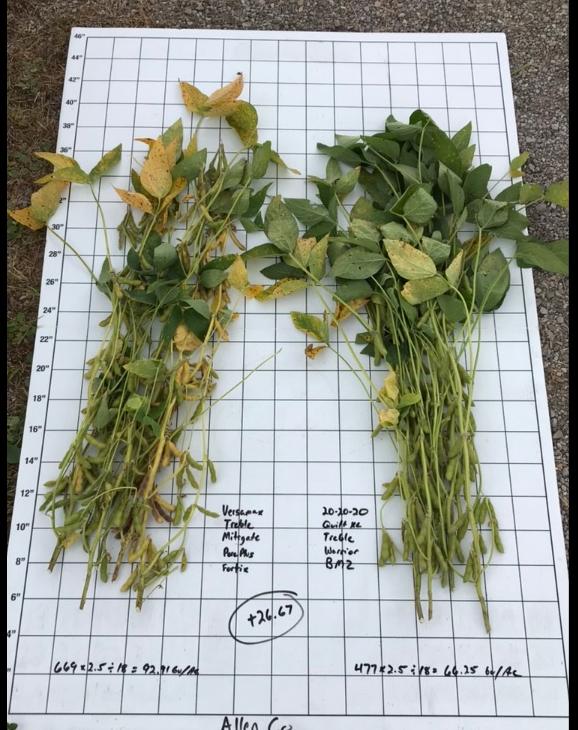
10/2/19 picture taken
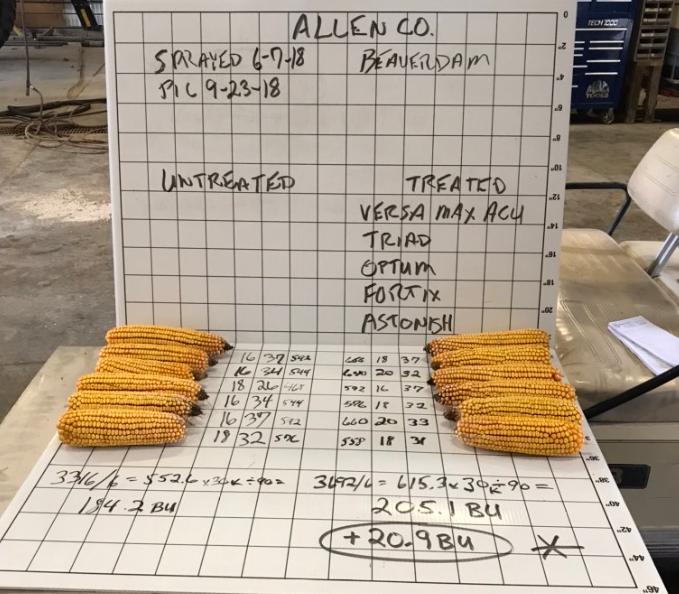
2018 corn trial
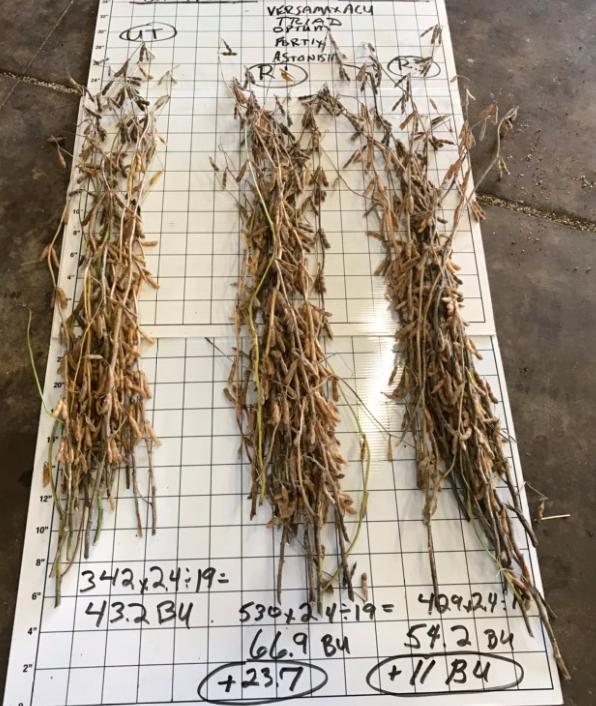
Soybean Trial 2018
September 20, 2019
Enlist E3 (Liberty, Roundup, 2,4-D tolerant) soybeans are currently available for sale. They will be the other alternative to Xtend (Dicamba) soybeans. E3 beans are competively priced but may be in short supply this year. Enlist One will be less restrictive to apply in soybeans against adjacent tomato fields.
September 16, 2019
As I travel a bit of Ohio and Indiana I realize we are blessed to have the crops that we have; I was in western Indiana last week and the corn was dry with yellow leaves, brown husks, and dropped ears. Late planting and early wet conditions likely caused poor root development. Unlike the Pandora Grain service area, this area did not receive consistent rains. The frequent rains here in NW Ohio carried our corn and soybean crops past the poor planting conditions and now we find ourselves asking if they will finish out before the frost. We are in a waiting game to see which happens first, the killing frost or maturation?
While we are waiting what can we do? One important thing to do is scout your corn for plant health and stalk integrity towards planning a harvest strategy. With the late planting we can expect higher harvest moisture and you may consider to let the corn stand out in the field as long as possible for natural drying. However, poor planting conditions, high soil moisture through the summer, and frequent rains in the late summer are prime conditions for plant diseases to compromise grain quality and stalk integrity. Foliar diseases like grey leaf spot and northern corn leaf blight can add stress to the corn plant compromising its defenses against ear rot, grain molds, and stalk rots. A good resource for corn ear rots and grain molds is provided by the Ohio State Extension here: https://agcrops.osu.edu/newsletter/corn-newsletter/2018-28/ear-rots-corn-telling-them-apart
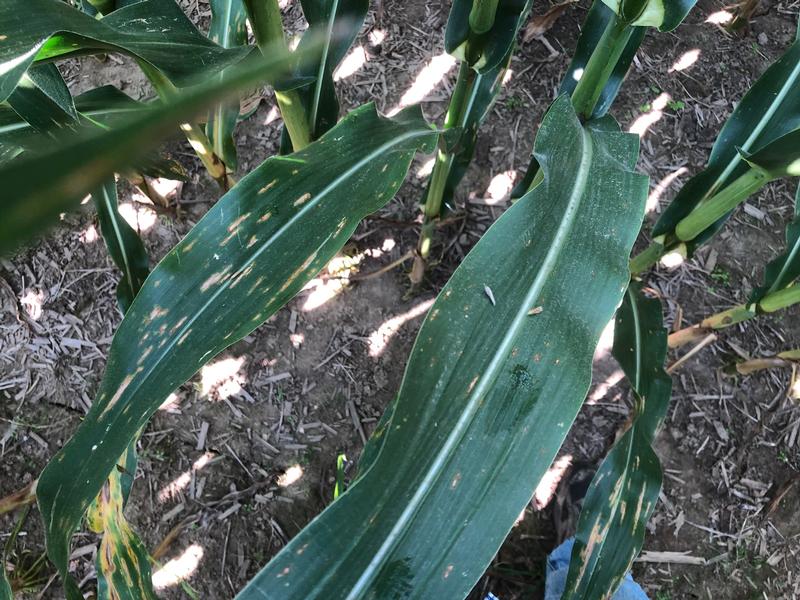
Stalk integrity is compromised by stalk rots and season long stresses on corn can increase stalk rots. Ohio State Extension provides information about stalk rots here: https://agcrops.osu.edu/newsletter/corn-newsletter/2018-33/stalk-quality-concerns
Scouting fields prior to dry down will be important so you can identify the more problematic fields and plan to harvest those first. Poorly drained fields, areas near trees or valleys that trap moisture, or your most difficult fields when planting this spring should be considered for early harvest. We all know well that the weather for 2019 has not been kind; it would not be wise to expect a turn around for the 2019 fall Season.
September 11, 2019
Fall fertilizer pricing is trending downward recently. With all the prevent plant acres in the area it would be a good opportunity to apply before the fall rush after harvest. It is also a good time to get caught up on soil sampling (or try it for the first time)! We are keeping busy catching people up on lime and gypsum applications after their newest soil sample results are coming back on prevent planted acres or wheat stubble.
We still have oats available for sale. They have good soil health benefits and get a good cover on the unplanted ground for the winter.
September 9, 2019
Seed pricing for Dekalb and Asgrow are here! Overall, prices are down from last year.
Waterhemp is becoming more of an issue in our area this year. We will be on the lookout for new areas of waterhemp infestation next year.
July 1 2019
If you have stopped and checked your wheat fields these last days you will see that there are many blank heads with visible signs of head scab caused by Fusarium. With the wet weather we had this spring head scab was almost inevitable. I surveyed over 40 fields in the region to score disease and better understand the variety and management reactions to the disease. The disease severity ranged from less than 1% to over 40% damage. Fields planted with advanced genetics having disease resistance and sprayed with a fungicide were best protected against yield losses and vomitoxin in the grain. Fields with only genetic resistance were not as good indicating that over 30 years of breeding research and improvement is not enough protection from the disease. Fields planted with older seed and sprayed or not were less protected from disease and will have high yield losses and very high vomitoxin levels. I also noticed some fields having high levels of Septoria leaf blight which is rare in NW Ohio since most varieties have a good level of resistance to this pathogen. In this photo the scabby heads are visible and the damage on the flag leaves is the Septoria tritici.
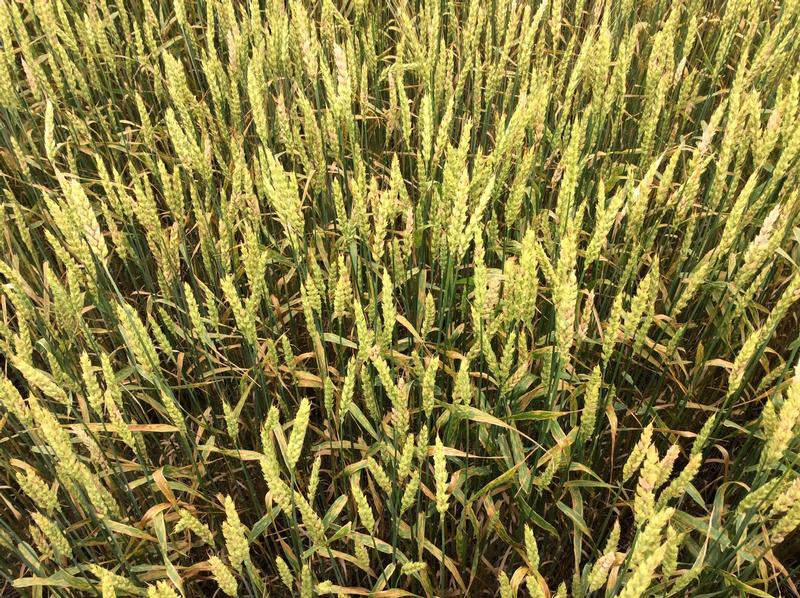
Despite the wet conditions this spring we were able to spray many acres with fungicide by air or ground. These acres sprayed with fungicide are eligible for harvest and delivery to Pandora Grain at 18% moisture with no drying charge. Acres not treated with fungicide by Pandora Grain will be subject to normal drying charges.
With harvest possible to start next week, here are some tips to help reduce the impact of scabby kernels in your wheat:
Increase fan speed and adjust your sieves to blow lightweight scabby kernels on the ground, 1-2 bushels of poor quality wheat on the ground is better than in the bin
Mange harvest moisture to maintain the highest crop quality and complete harvest before damaging rain. The vomitoxin content increases in the grain if it has reached maturity but is rained on in the field.
Heavily damaged grain may serve as a cover crop, I ordinarily would discourage using wheat as a cover crop but in some instances it may be an option to use poor quality grain.
A season like 2019 is a good reminder that managing wheat like a row crop will have good rewards. If wheat is part of your rotation or you may be thinking to add more wheat acres for 2020, take advantage of this learning opportunity to select new varieties with high yield, the best resistance to head scab, and evaluate the value of fungicides. Consult the staff at Pandora Grain and Supply to help you realize the best value of your 2020 wheat crop. Diseased wheat is only valuable to wheat breeders
June 19 2019
Waterhemp has been found in our customers fields, I found a 5” plant on June 5 and on June 12 we
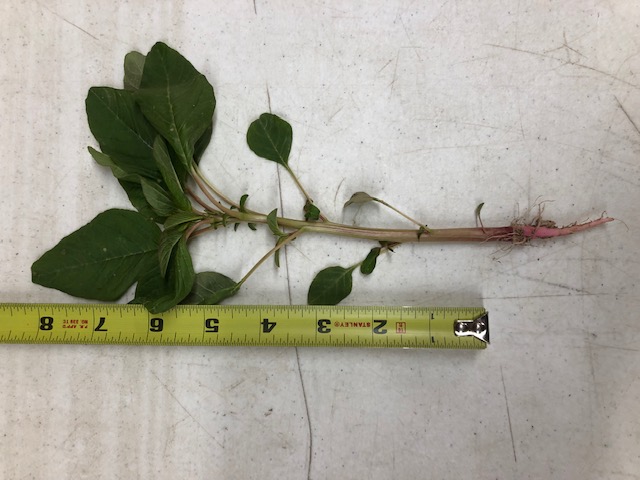
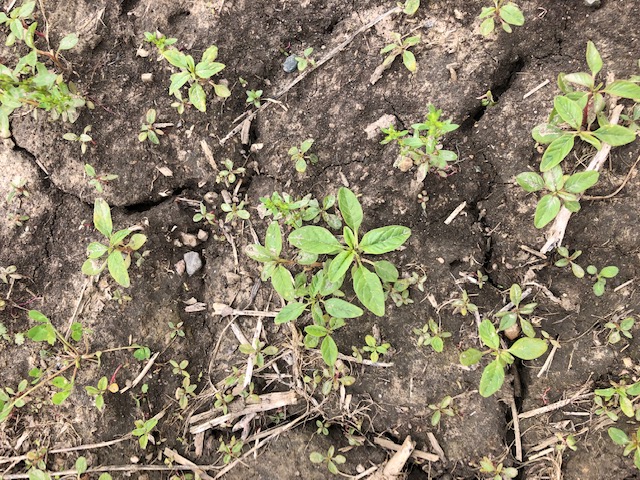
identified a plant likely to be Palmer Amaranth. Juvenile plants are more difficult to confirm but we communicated with the local extension agent and agree that the prudent action is to treat as Palmer Amaranth. The infected area in the field is next to a creek and flooding occurred likely spreading weed seed into the field.
With this rain we have not been able to apply residual herbicides to control the Marestail, Giant Ragweed and other prominent weeds. We had plans to control Waterhemp and Palmer Amaranth with layered residual chemistries but we have not been able to apply these herbicides. It will be important to scout your fields for Waterhemp and Palmer Amaranth even if they have not had a history so that we can prioritize fields for best control. Be especially diligent in scouting along creeks and areas that flood. Treat these weeds like a cockroach that if you see one, there are more hidden in the woodwork. Please contact your local extension agent if you think you see these weeds. Also contact Pandora Grain and Supply personnel to discuss your control options. With the delayed planting and potential prevent plant acres weed control will be very important. Also with the shorter growing season and possible yields it will be important to maintain your full herbicide program to prevent weed problems in the future seasons. Please scout your fields for weeds and visit with the staff of Pandora Grain and Supply to review your herbicide options so that you have the proper chemistries including layered residuals to control weeds in 2019 so they do not explode and cost you in 2020.
May 23 2019
As we are nearing the end of May with little to no spring field work done the last thing we want to talk about is the weather. Over these last weeks I have often heard it said that when the faucet finally shuts off, it will stay off. That is to say that we could see dry July, August, September after this unprecedented rainfall in April and May. To better prepare my thoughts for the season ahead, I pulled monthly rainfall from the National Weather service collected at the Findlay Ohio airport from 1980 to 2019. The combined 2019 rainfall for April and May at the Findlay airport is approaching 12 inches with more predicted. For this period, this is the wettest year since 1980. When it comes to the weather, I actually do not let historical trends grossly influence my decisions and I typically stick to my plan but I like to think of Eisenhower’s quote “plans are useless, but planning is indispensable”. I reflect on this quote at this point in 2019 so that when I am walking our fields with a spade, digging to see how wet it is, I think about the entire season that lies ahead of us and do not let the current weather completely influence today’s action.
We do not know what weather June, July, August, and September (JJAS for short) will bring but if they are cooperative we could have another instance where June planted corn is some of the best we have ever experienced. However, if JJAS remain unfriendly then we could have another difficult fall. Many have concerns for drought stress in JJAS; of the five years with the wettest April-May, there is equal chance of a dry as a wet summer 2019.
A good resource of how to deal with the Wet Spring Soils is provided by the USDA NRCS here: Dealing With Wet Soils
How do I plan to use this information when I am in the planting tractor? It will be very important to be patient and heed the advice in the document that if is not fit, do not make a bad situation worse. Planting depth will be important to not plant too shallow, but not create more compaction. If JJAS turns dry then we need good root depth for pulling water from the soil. If this period remains wet, crops will need deep plant roots to better anchor and prevent stalk or lodging problems in the fall. Planting population may help compensate for late planting but as of May 23, I will plant the same population as planned. If we are delayed into mid-June I may increase my bean population but will still hold corn population.
For soybeans, remember that flowering and reproductive growth is triggered by day length and so with later planting the plants produce less leaves and stems and so there are less chances of making pods and seeds. Increasing population can provide an opportunity to compensate for less overall nodes. Keep in mind that soybeans are a plastic crop that they can adjust grain yield at most points in the growing season.
If we do have a window to plant corn remember that corn is not very plastic with yield determined by kernels set around the ear at V6 stage and ear length determined when the corn is knee high to two weeks before silking. Stress at these growth stages can greatly reduce yield and June planted corn is more likely that key yield stages will occur during stress periods. Hasty decisions when planting corn can increase plant stress. Of a greater concern for corn is heat unit accumulation for JJAS, of the 10 years with the most rainfall in April-May, five of those years were among the lowest 25% for Growing Degree Day (GDD) accumulation. That is 860 average GDD for the ten wettest April-May compared to 970 for years with average April-May rainfall. That is to say that if we have a wet April and May, we are more likely to have a cooler grain fill and maturation period than an average or dry year.
When we are able to plant, be safe, with this modern equipment many rows make light work. Think about your soil compaction, mistakes at planting may be seen for years to come. Feel free to come in and visit with the staff at Pandora Grain and Supply and talk over your planting and herbicide needs as your previous plans are almost useless but the planning today will be invaluable.
April 4 2019
It is early April but the weather still feels a lot like early March; at least the days are getting longer and it is easier to think about field activities this summer. In crop spraying is two months away and we have time to prepare for herbicide related issues like waterhemp, spray drift, carryover, and tank cleanout. Proper planning these cold days of April will reduce these avoidable headaches in June. Whether you spray your own crops or hire custom application, all aspects of herbicide selection and application have risks and opportunities for errors.
When we were spraying roundup as a burndown and post application on corn and soybeans, herbicide drift was mostly controlled by watching wind speed. Triple rinsing the tank with ammonia cleaned out most of the active ingredients. Now with the incrop applications of Xtendimax and other Dicamba based herbicides on soybeans and not all soybeans being Dicamba tolerant attention to detail becomes more important. In 2019 we will have non-GMO, Dicamba+Roundup, Liberty, Liberty+Roundup, Liberty+Roundup+2,4-D, and GT27 soybeans in the field this year, we a have complex soybean herbicide puzzle requiring record keeping and proper sprayer clean out. We may want to say that in 2020 or beyond these traits will be stacked in most seed varieties and things will be easier. Remember that we are in the 2019 crop season and a mistake this year may adversely affect your abilities to spray in 2020.
What steps need to be taken in 2019? If you are spraying or assisting to spray Dicamba products on soybeans you are required to attend a BASF, BAYER, or CORTEVA sponsored training. If you have not already attended a Dicamba training, all applicators and personnel connected to application must attend a training. Please contact us if you need help to find a training in the area. You may also take a computer based training available here: https://training.roundupreadyxtend.com/.
As I think about the 2019 spraying season, COMMUNICATION is paramount for making this season a success. Communication tools like field flags denoting the herbicide, marking your high value crop or hobby with https://driftwatch.org/, mailing or texting all your neighbors of what is planted in your fields are all good methods of communicating what and where you planted. Communication also includes proper record keeping of what was sprayed in the field, what was the previous chemistry in the sprayer, what tank cleaners were used etc., these data are required for your Dicamba spray records additional information can be found here http://www.xtendimaxapplicationrequirements.com/Pages/default.aspx.
Additional information about herbicide clean out can be found at these websites
https://cropwatch.unl.edu/2018/removing-dicamba-residues-your-sprayer-tricky-task
http://www.kalo.com/products/Detail.aspx?ID=2f3bfc55-f6cc-4fc0-bd7c-6cb4b0ccbd4d&Type=2
http://www.agphd.com/wp-content/uploads/2015/05/SPRAYER-TANK-CLEANOUT.pdf
https://www.uaex.edu/publications/pdf/MP532.pdf
https://ppp.purdue.edu/wp-content/uploads/2016/08/PPP-108.pdf
It is important to keep in mind that Tank Cleaning and herbicide drift are not new topics, but with the last 20 years of Glyphosate being the major herbicide used, we lost some of our skills and respect for the chemistries that we will use in 2019. Pandora Grain and Supply is making preparations to assist you in all aspects of your 2019 spray season. We will spray Xtendimax herbicide incrop on soybeans. We are upgrading our spraying equipment, the staff are also attending trainings to update their knowledge, and we are improving our communications with customers. Please communicate with us by phone or stop in at the Pandora office so that we all can be on the same page and make this a successful 2019 spray season.
?
January 31, 2019
What is pH? I doubt many of us think about that on a daily basis, if even on a weekly basis. If you farm or have something to do with farming, the pH of your soil can greatly influence your productivity and should be a frequent topic of conversation. The Pandora Grain and Supply staff attended a Soil Fertility Workshop presented by A & L Great Lakes Labs https://algreatlakes.com/ where I was reminded of the importance of properly managing your soil pH; Jeff Hunker diligently samples your fields, surveys your records to provide you the best results to manage your fields. As you are working on your 2019 crop plans and you have not thought about the pH of your soil, it would be a good idea to visit with Jeff about sampling your fields. The recommendation is to sample every four years, if it has been longer than that, your soil pH may be off by more than just a little bit and may take more of an investment to bring it back in line. Keep in mind that some people are realizing financial savings from sampling every two years.
To maximize the value from sampling, routinely sample in the same season and in the same crop residue for repeatability towards assessing trends and valuation of improvements. Treat soil sampling like home repairs, a little maintenance will prevent a large repair bill in the future.
By this point you may be again asking yourself what does the pH do and what does it really do to my soil? It will affect nutrient availability, herbicide activity or breakdown, and even microbe activity, ultimately soil health. Good information about soil pH can be found here https://www.nrcs.usda.gov/Internet/FSE_DOCUMENTS/nrcs142p2_053293.pdf
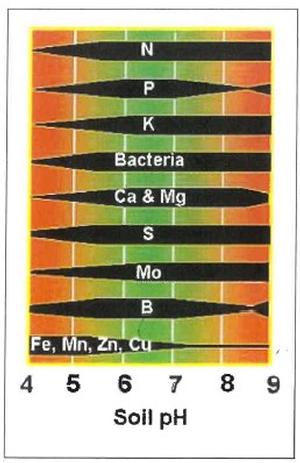
A key nutrient for crop and algal growth is Phosphorus, and in this figure you can see that its plant availability is reduced when the pH falls below 6. Soil phosphorus is most available from pH 6 to 7 allowing you achieve maximum value of your P in areas with excess that otherwise may contribute to nutrient run off into Lake Erie. We recommend a pH of 6.5 so the micro-nutrients Copper, Iron, Manganese, and Zinc are more plant available to best feed your crop.
To offer greater service to you, our customers, the staff of Pandora Grain and Supply are digging deep into our liming and fertility recommendation equations and seeking opportunities to tailor our VRT recommendations to more closely reflect your farming operation. We are building our knowledge base and tools to provide you better knowledge of the chemistry in your soil allowing you to make better decisions.
As you are budgeting for 2019 and beyond, be sure to work with the staff of Pandora Grain and Supply to sample your soil routinely and use that information to develop recommendations for a solid pH foundation and fertility program to best provide you profitable returns.
December 26 2018
Putnam County Soil and Water Sponsored talk by Dr. Chris Winslow of the Ohio State University.
Dr. Chris Winslow presented information developed in cooperation with several public and private Northwest Ohio universities, non-governmental and governmental agencies. Dr. Winslow discussed that the research and recommendations towards reducing Phosphorus accumulation in Lake Erie are made to support continued agriculture in the watershed while improving Lake Erie water quality. This work demonstrates that the algal bloom frequency increases with increasing torrential rain events. Peak bloom years like 2009, 2011, and 2015 coincide with peak rainfall years, and dry years like 2012 have much less algal growth; most fertilizer runoff occurs from 10 rain events per year. Another way to say it is that few but large rain events contribute most of the nutrient loading and algal blooms. This is not news but it does reiterate that the weather which is beyond our control and becoming more variable greatly impacts water quality.
Within our control is nutrient application and limiting nutrient runoff. Regardless if the nutrients are from commercial fertilizers or manure, the actions and management practices we employ are the first steps towards cleaning up Lake Erie. Information of Best Management Practices (BMP) can be found here:
https://agbmps.osu.edu/bmp/crop-application-manure-sourced-nutrient-maximize-crop-uptake
In some cases financial support by Environmental Quality Incentives Program (EQIP) may be available for first time BMP adoption. When investigating a BMP and possible financial support, it is important to think about a practice that you would be willing to continue even if there was no financial support. Use the support to help reduce risks that you may incur due to changes in your farming practices. An example of a BMP might be cover crop, grass filter strip near a water way or ditch, or grid sampling with Variable Rate applications. It is very important to point out that from the 1970s to the mid-1990s farmers followed recommendations that Phosphorus was stable in the soil and could be “banked” applying Phosphorus at rates 10-40 pounds above crop removal. With broad adoption of the Tri-State Fertilizer recommendations, Phosphorus application rates are now below crop removal in an estimated 60% of the acres in the Lake Erie Watershed. There is room for improvement that 40% of the acres are at about 5 pounds per acre Phosphorus above the recommended crop removal rate. To improve those acres, high density soil sampling and variable rate technology would be good tools to help apply Phosphorus at rates below crop removal at no yield penalty.
Dr. Winslow pointed out that agriculture is not the only source of algal nutrients accumulating in Lake Erie. Urban fertilizer can be a source especially if a starter fertilizer containing Phosphorus is improperly used to maintain a lawn. Urban runoff from under capacity combined storm water and sewer systems may result in algal nutrients draining into Lake Erie. Additional sources of Phosphorus in the water are not from agriculture, however the facts are that over 80% of the Phosphorus runoff occurs from non-point or undetermined agriculture sources.
Beyond rain and nutrient application, geologic features of Lake Erie compared to the other great lakes and the surrounding land area lead to higher nutrient runoff and algal blooms. Lake Erie is the shallowest of the Great Lakes at 210 feet compared Lake Michigan the next shallow at 750 feet. In terms of percent watershed land use Lake Erie has 19,500 square miles of its watershed area is in agriculture with Lake Ontario having about 15,000 square miles in agriculture. Lake Erie’s unique geography allows the lake to warm up more in the summer and be more conducive for algal blooms and toxin production. Right now the focus is on Phosphorus fertilizers, but Nitrogen is becoming more closely watched as its concentration in the algae may be related to the actual level of toxin produced. The algae are unsightly to look at, but if they do not produce a toxin then the health implications are less serious. Phosphorus runoff is related to algal bloom growth, but it may be both the level of Phosphorus and Nitrogen in the water that may lead to the toxicity. As we control Phosphorus runoff, we should also work to reduce Nitrogen runoff too.
The Phosphorus accumulation in the Lake Erie watershed did not happen overnight, it occurred over a 50 year period that farmers followed nutrient recommendations and the human nature to work hard with the gifts of soil, knowledge, work-ethic, and passion to feed the world. In following that passion we cleared and drained the land, in doing so we unknowingly changed the Lake Erie ecosystem and now we are working to reverse that trend. Unfortunately, we do not have the 50 years that created the problem to correct the problem. To that end, the staff at Pandora Grain and Supply are here to help maintain your profitability while complying with the changes in fertility management. We are taking initial steps towards becoming 4R certified, we have a growing customer base utilizing grid sampling and variable rate fertilizer application, we are working to provide information and work with governmental agencies to support Best Management Practices like cover crops, and are looking to sort through and adapt new technologies to ensure the crop nutrients we sell and support feed the crop, and not the lake. As we close 2018 and open 2019, please consult our team to explore ideas to reduce nutrient runoff and your profitability.
December 5 2018
The personnel of Pandora Grain and Supply work to support your seed needs by conducting demonstration plots of the major seed brands we offer, ASGROW soybeans, DEKALB corn, and SCHLESSMAN Seed corn, soybeans and wheat.
The 2018 corn and soybean plots were in adjacent fields and the Pandora plot was located at State Route 12 and Putnam County Road 1 and the Beaverdam plot was on State Route 696 ½ mile south of Columbus Grove Bluffton Road. Corn plots were planted on May 11, at 32,000 seeds per acre, the Pandora corn plots were four rows wide and at least 400’ long with increasing length. The Beaverdam plots were three or four rows wide due to limited seed quantities but all plots were 900 feet long, not all hybrids were planted at both locations and are blank in the results table. Starter fertilizer was applied at 10 gpa 28% with 1 quart TraFix Zinc. The soybean plots were planted on May 24, population of 180,000 and 7.5 inch spacing. The Beaverdam plots were 7.5 x 530 feet and Pandora plots were 15 x 950 feet.
The soybean plots were harvested on October 16 and the plot average was 79.7 and 81 bushel per acre at Pandora and Beaverdam, respectively. The corn plots were harvested on October 22 and the corn plot average of all entries was 232 bushel per acre at each location and bean. Similar relative maturity competitor corn hybrids and soybean varieties were included in the test plots for comparison and identities are concealed.
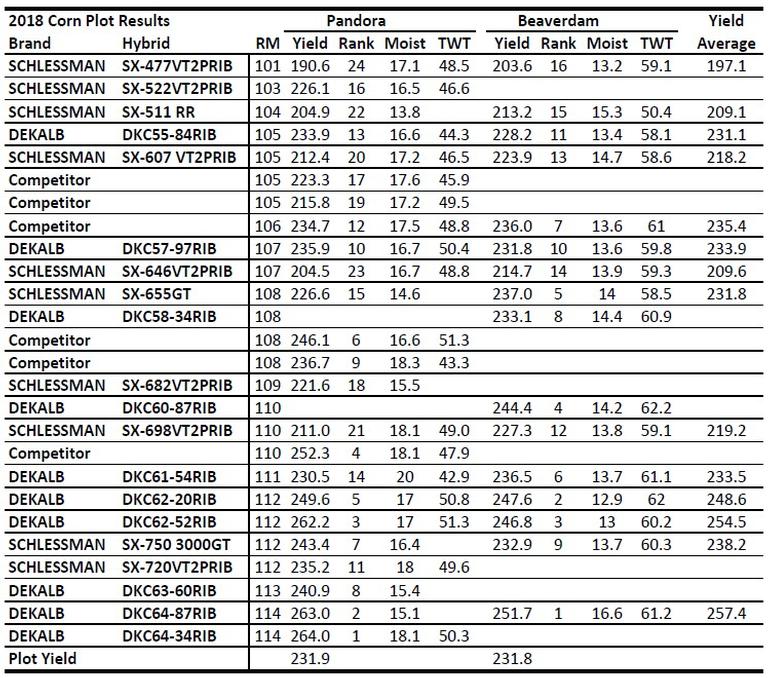 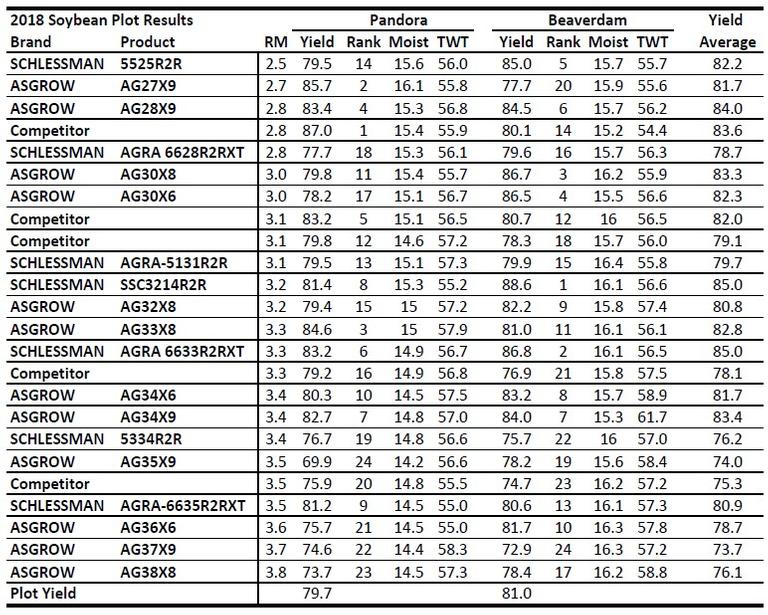
These results will provide you a general idea of the local product performance, this information is useful but should not be the only criteria you use for determining your 2019 seed products. Yield stability, disease resistance, standability, herbicide resistance, etc. are all factors affecting your seed decisions. The staff at Pandora Grain and Supply will assist in evaluating these and additional results to best select seed products for the 2019 season.
October 31, 2018
2018 harvest is winding down, we had an early start, rains stymied bean harvest but now the first crop beans are mostly harvested and many double crop are harvested. Fortunately the corn has been dry enough to harvest and has been good for the calendar date. We have had a few frost events and with the recent colder temperatures, cover crop growth will be slowed and summer annual plants have terminated. The November weather is predicted to be above average temperature and the recent rainfall will be ideal conditions for germinating biennial (Marestail) and winter annual weed (Dandelion, Henbit, and Chickweed) growth.
It will be prudent to scout fields these next weeks as fall herbicide applications may be a sound investment. This is not a new topic but emerging weed problems like Waterhemp and Palmer Amaranth will dig deeper into your herbicide budget already stretched thin by Marestail, Dandelion, Henbit, Chickweed, and Ragweed (just to name a few). Unfortunately, all weeds are requiring more investment of your time and inputs for control. When thinking about weed control and an economic herbicide budget, be proactive and control weeds before you see them. Proactive weed control helps reduce aggravation and we won’t need to think about herbicide rescue treatments. Rescue treatments will not work to control Waterhemp; we need to control these weeds before we see them.
For controlling Waterhemp or Palmer Amaranth in Xtend or Liberty beans in 2019, it will require diligent scouting and timely herbicide applications. It is possible that four applications with a layering of different active ingredients and residual chemistries will be needed. Weed control will start in the fall as either spraying or tillage to control winter annual weeds. With the harvest progress and possibly a long fall for tillage, it will be tempting to chisel and prepare stale seed beds for early spring planting. Keep in mind that soil erosion carries nutrients into waterways. If the soil is left unprotected all winter it will be made available to erosion and nutrient runoff that may contribute to an algal bloom in 2019.
Fall spraying to control winter annuals with synthetic auxin products like 2,4-D and Dicamba (Group 4) is also effective. The major questions for controlling winter annual weeds in the fall are when is the best time to apply and do we need a residual herbicide like Metribuzin (Group 5)? The chart of the herbicide groups is here:
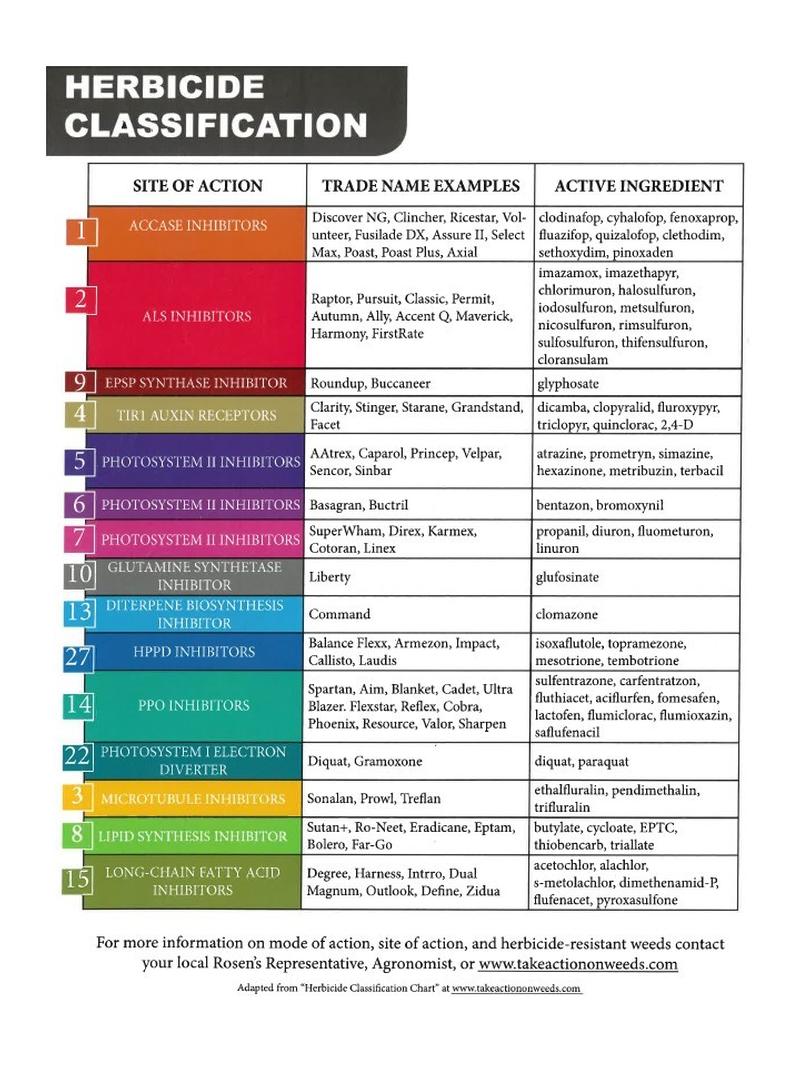
If spraying earlier in the fall then it is better to include a residual to extend the coverage window. If spraying later in the fall then you may leave out the residual product but you also run the risk of being rained out and not being able to spray at all. It is also important to not spray soon after a frost as weeds are not actively growing after a frost event and systemic herbicides are poorly absorbed and translocated through the plants
https://agfaxweedsolutions.com/2017/08/18/indiana-fall-applied-herbicides-controlling-waterhemp-winter-annuals/.
Fall weed control is part of a weed management system eliminating weeds while they are actively growing at juvenile growth stages will be helpful in the spring allowing for better layering of other chemistries to treat problematic summer annual weeds like Waterhemp. Pandora Grain and Supply has started fall spraying and our personnel will assist you in developing a weed control program for 2019.
October 12, 2018
Like many of you, I tend to run mental after action reports of what worked and what did not for a given season. Our combine is not brand new but new enough to let me watch grain moisture and yields across the fields. That offers me a great opportunity to evaluate the season as I planted most of our crops, harvested most of our beans, and shelled much of our corn. I scrutinized our season for improvements to make in 2019 and the first task is the planter driver must do a better job or be replaced since he forgot to increase the population of our first field.
On our Leipsic and McComb soils, the beans were good but the yields did leave us wanting more. I am not sure if it was compaction, disease, or what is missing in this equation. All season long I walked our fields and could feel how hard our soil is; the beans were always in a greenish yellow funk, a foliar fertilizer strip was no better than the untreated area. We are well tile drained, principally no-till, and stay out of the fields when the soil is prone to compaction. As I dug plant roots looking for signs of compaction, I noticed how hard the soil was and more root growth in the direction of planting than laterally. We have pulled soil samples, pH is good but like most farmers we opted for the cheapest source of lime focusing on moving the pH not thinking about the physical changes of the soil. As a result our Calcium to Magnesium ratios are much lower than I would like and we will apply gypsum to correct this. Not sure if this is the problem or not but I want to make sure we work to correct the simple problems before the more complex, when you hear hooves, think horses not zebras.
Our corn is doing well, the ideal weather early in the spring created very high yield expectations but they were right-sized for our conditions, we will have more corn than we know what to do with but maybe not as much as we hoped for soon after planting. The 2018 corn season was a low nitrogen use year with little denitrification. I estimate our nitrogen use efficiency at 0.9 pounds N per bushel corn. Historically, high (almost excessive) Nitrogen rates produced high corn yields but todays modern hybrids are more Nitrogen efficient and produce less protein per bushel than more historic hybrids. If plants are making less protein per bushel, then less Nitrogen per bushel is required compared to older hybrids. Simply put, increasing corn yields will not require equally increasing nitrogen rates. This is a welcome thought with todays low corn prices and higher nitrogen prices.
It would also be useful to assess unused Nitrogen with a stalk nitrate analysis, we ran stalk nitrate analysis on our 2018 corn and found that we have excess N left in our stalks. A reaction from these results would be to cut Nitrogen rates for next season, but would that really be a good idea? If we would have had a wet spring with more denitrification we likely would have less nitrogen in the stalks and could have actually run out of nitrogen for the crop. We routinely plant cereal rye cover crop following corn so we have a chance to scavenge much of that Nitrogen as it breaks down. This season we ran side by side of a nitrogen stabilizer to see if there is a yield benefit. Initial field response does not appear to be any yield difference, but was this really a fair comparison? In a non-denitrifying year like 2018 I suspect we would see less advantage to a nitrogen stabilizer. To some of you there is little question about using nitrogen stabilizers. However, with the current fertilizer prices rates may be in question, with the increased value of nitrogen and increasing use of stabilizers could we apply less N and yet still produce the same crop or at least increase our nitrogen use efficiency? It is getting late in the season for stalk nitrate analysis but you may consider this tool to help understand your nitrogen use efficiency.
When scrutinizing this 2018 season, it will be important to determine the economic nitrogen rate for your farm in 2019. The Corn Nitrogen Rate Calculator available here
http://cnrc.agron.iastate.edu/
is useful to assess economic yield thresholds based on nitrogen prices and crop value. I admit that I think this tool is a useful guideline. With the annual risk of denitrification from excessive rains, it is tough to stop from adding that “little bit more” Nitrogen so we can sleep better at night comfortable that we fed our crop. With the new technology, breeding improvements, higher fertilizer costs, and , it may be time to reevaluate your nitrogen rates and plan strip trials of nitrogen rates in your fields to help you better understand nitrogen utilization on your farm.
When thinking about Nitrogen, I am reminded of my wheat experience and a saying that a popular cereal company had about sugar “it will cure other sins of the grain” point being that nitrogen has been used like sugar that a little more will cover up other problems for the season. Our crops are biological organisms needing well balanced meals. Similar to dealing with a hungry toddler, it is easier to plan and prepare meals when they are sleeping than when they are crying. The same approach to feeding your 2019 corn crop may be advisable. Remember that personnel at Pandora Grain and Supply are here to help you with your nitrogen decisions for 2019.
Sept 24 2018
With the variable wet weather this year, corn ear rots may be an issue at harvest. Ohio State Extension recently put out diagnostic information of the ear rot samples farmers are seeing. The information is available here:
https://agcrops.osu.edu/newsletter/corn-newsletter/2018-28/ear-rots-corn-telling-them-apart
I made a tour of customers corn fields last week where I picked a representative area and husked back 10 ears looking for Ear Rots and inspecting the overall integrity of the crop. In many fields all ten ears were clean, in some fields 1-2 ears would have Diplodia Ear Rot or sometimes Gibberella Ear Rot. I did find one field where five of the ten ears had Gibberella ear rot with the most severe ear being about 15% infected as in the first photo, but this was very rare across the region. This hybrid had a very tight husk and upright ears compared to most of the other hybrids having open husks and drooping ears. Fortunately other fields in the area did not have the same level of Gibberella so this should not be a big issue come harvest. We tested Vomitoxin levels on the grain samples I collected and are confirming our results with the official lab. Unofficially, we were comfortable with the Vomitoxin levels in the grain potentially having Gibberella.
Most of the infected ears across the region were more like the second photo where there is a white mold growing in the middle to lower portion of the ear. This symptomology is more consistent with Diplodia Ear Rot and mycotoxins are not associated with this disease of corn.
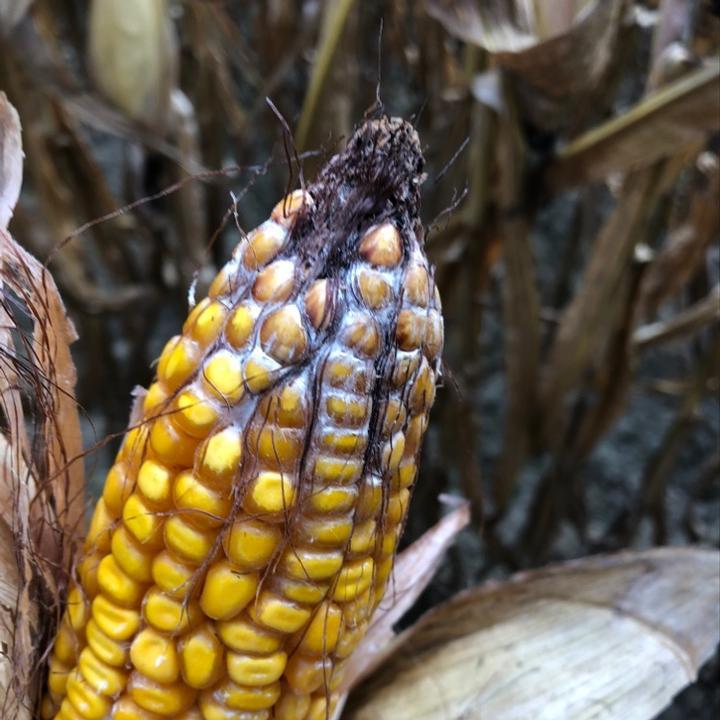 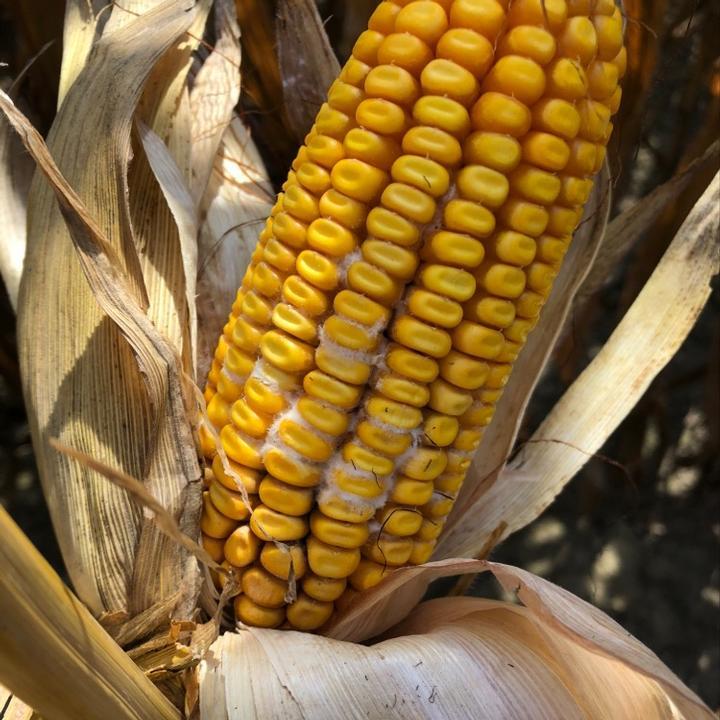
With the wet weather these last days there may be additional concerns of increasing Ear Rot infections. The warmer temperatures at the end of last week did help dry the corn down and much of it has black layered or reached physiological maturity. This weather prior to this weekend’s rain helped the corn avoid increasing ear rot infections. Most of the corn ears have dropped down preventing rain water from entering into the ear and husks are open facilitating evaporation of the water in the ear.
I would not say that we should totally dismiss corn Ear Rot in the fields this harvest but from what we have analyzed it should be isolated. Prior to harvest, it would be good to inspect your hybrids and assess levels of the Ear Rot and overall grain quality. If you find a field having higher levels, it may be time to replace that hybrid or at least ask what conditions caused this to happen when most other hybrids avoided severe infection.
August 31 2018
As I drive through the countryside, I find myself looking at soybean and wheat stubble fields trying to identify Waterhemp among the Pigweed. I have to stop and feel for a smooth stem because a windshield diagnosis is not accurate for this weed. A week ago I checked my field own field of wheat stubble near McComb. My heart sank as I grabbed a smooth stem, reality, panic, then relief set in as I looked at the leaves recognizing it was Common Lambsquarters and not Waterhemp. The next day I was driving north of Glandorf and spotted Waterhemp in a friends field; I stopped to diagnose and confirm. I didn’t have time to chat long with my friend’s father as I was late for a meeting in Fulton County. At that meeting was a farmer also from this same area north of Glandorf; I introduced myself and the conversation quickly became about Waterhemp management. I realized how much more wide spread this problem weed was; this weed is very serious, controlling it will require managing multiple herbicide modes of action and terminating the weeds before they are able to reproduce.
To help farmers prepare for controlling Waterhemp, the Putnam County Ohio Extension office offered a workshop on August 28 for real time weed diagnosis and management discussion. Dr. Jeff Stachler of the Auglaize County Ohio Extension office discussed the biology of the weeds. Waterhemp is dioecious having distinct male and female plants, it is necessary for pollen to physically move from the male plant to the female plant for pollination and seed development. The male flower is typically more compact and the individual floret will open to release pollen and the female flowers typically have more branching.
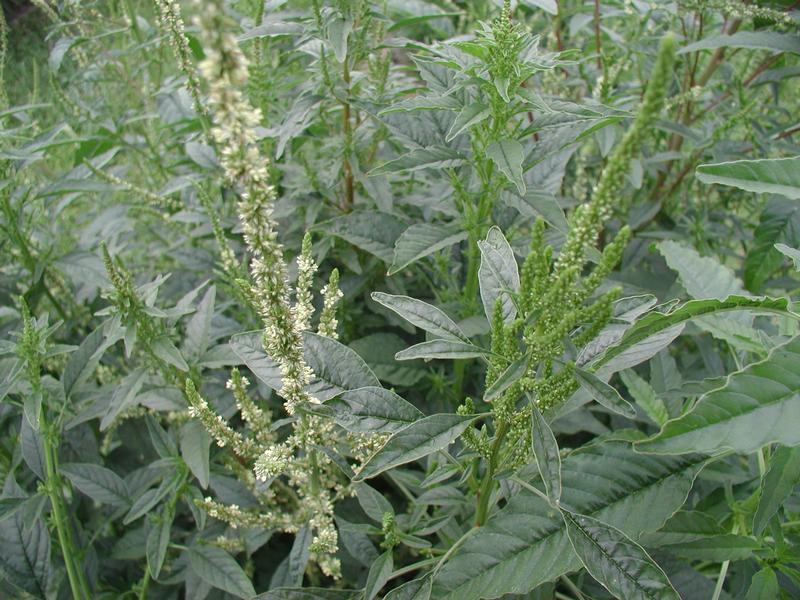 This photo from the website http://soilcropandmore.info/crops/Weeds/common_waterhemp.htm provided by Texas A & M university has male Waterhemp on the left and female on the right. This photo from the website http://soilcropandmore.info/crops/Weeds/common_waterhemp.htm provided by Texas A & M university has male Waterhemp on the left and female on the right.
Like, livestock breeding it only takes one strong sire to breed a large herd of females. This cross pollination and hybrid growth leads to tremendous genetic diversity rapid ability to develop herbicide resistance. Selection pressure by repeated herbicide use has contributed towards stacking resistance to multiple herbicide modes of action. The groups 2 (ALS inhibitor), 4 (Auxin receptor), 5 (Photosystem II receptor), 9 (EPSP Synthase inhibitor), 14 (PPO inhibitor), and 27 (HPPD inhibitor) have had resistance selected and combined by cross pollination. Until this meeting I was thinking of Waterhemp as a true breeding inbred but during the conversation I realized these Waterhemp seeds are hybrid much like the hybrid seed corn you plant The same principles of plant selection for crop improvement to make crop plants more vigorous and resistant to stresses are also applicable to the aggressive growth of Waterhemp. That same aggressive vigor and stability we seek in our crop seeds is also being selected for in our weeds. They are becoming more vigorous and aggressive. As a former plant breeder, I am envious of the speed and efficiency that biology had evolved and recombined against the unintended selection pressure we imposed with the repeated herbicide use.
Dr. Stachler discussed and presented results of his research; his message has been consistent with our message to you our customers that we need to aggressively control Waterhemp and by doing so we should also prevent Palmer Amaranth from taking root.
The recommendations are:
- PRE (high rate/2-4 active ingredients) followed by 1 POST
- Watch for Soybean injury
- May need second post
- Pre followed by 2 POST
- Mix active ingredients otherwise may select for resistance
- Second POST may be too late for soybean stage; watch labels
- Liberty = R1; dicamba = R1; fomesafen = only one application
- PRE followed by POST + Residual
- Need rain to activate
- Existing plants need to be controlled
Mixing active ingredients and controlling Waterhemp before you see it is the best system, waiting to see the weed is not an option as the weed grows too aggressively and weed escapes will cross breed to create populations resistant to the few active ingredients that do kill this weed.
If you are not yet concerned about Waterhemp in your fields, then maybe this photo of Palmer Amaranth from here in Putnam County will heighten your worry.
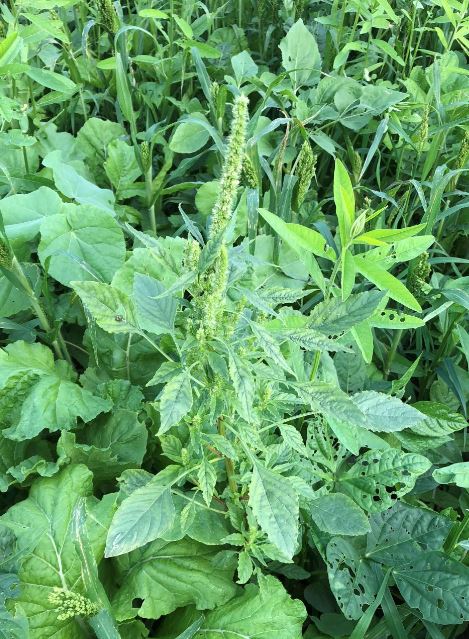
-
August 17 2018
The planted wheat acres of Allen, Hancock, and Putnam counties was 63,800 acres in 2016 and 53,500 in 2017, a 17% reduction. Much of the lost wheat acreage has been due to better cash prices for corn and soybeans which have less risk of losing value like wheat. All it takes is marginal weather in the spring and a wheat crop that survived the winter with good potential can be lost thanks to head scab causing vomitoxin or stripe rust taking yield. We have had three good years of wheat in Northwest Ohio, losses due to diseases like head scab or stripe rust have been minimal. You may be wondering if we can have a fourth good wheat year? Fortunately, breeding for resistance to these diseases and increased grain yield along with foliar application of fungicides has helped improve wheat stability. With recent price inversions of corn and soybeans compared to wheat, more farmers are considering to plant wheat for the 2019 crop. That is good news to this former Wheatie, but that does also bring me concern that a hasty decision to plant wheat in the fall can create a headache in the spring. I do not want to discourage anyone from planting wheat, but I do want to encourage everyone planting wheat to invest their time to manage wheat like a row crop.
The first consideration of planting wheat this fall is which field? Not surprising, but high yielding wheat comes from the same high yielding corn and soybean fields. If you are planning to plant wheat in fields that need work you will want to select appropriate varieties to match the field conditions. If you are willing to plant wheat in your highest yielding field, pick a racehorse variety, manage it properly, and you will set yourself up for yield potential and bragging rights for years to come. Since wheat acres have been decreasing, seed companies have responded in kind by producing less seed, it may take more work to find premium seed and it may be tempting to buy bin run seed from a local source. I would strongly discourage planting bin run seed; it may be a mixed lot and you do not know what you have, a seed lot of mixed varieties may have sub-par germination. In 2018 we had some pre-harvest sprouting and it seemed that ‘whiter’ wheat was more likely to sprout which is consistent with my experience. Also, many of the current wheat varieties are patent protected and purchasing that wheat to plant as seed would be in violation of the patent. Additionally, with the increased waterhemp in the area, it would be risky to buy wheat that has not been systematically inspected to protect against spread of this noxious weed. These are all compelling reasons to purchase known quality seed.
Timely planting is very important, planting a few days before to two weeks after fly free date is the best window to plant wheat. Top growth going into winter is a concern, but I have planted wheat from St. Louis to Detroit, the times we lost wheat to frost damage we planted very early near Evansville, IN. Not to say you will not have risk losing wheat planted in late September, but the reward is greater than the risk. Obviously soybean harvest impedes wheat planting, If you have late group II to early group III beans you should be okay to plant wheat. But if you are thinking to follow a mid to late group III bean with wheat, you may want to think twice. Late planted wheat can be compensated by increasing the planting population, but there are limits.
If you are still reading this and I have not discouraged you from maintaining or adding wheat to your rotation, there are many benefits you may see:
· Can spring overseed red clover to build the soil health, add nitrogen and organic matter
· Post wheat harvest is a good time to grid soil sample and make soil amendments.
· Summer deep tillage is a great option to break up compaction.
· Increase crop rotation to help spread workload, and decrease disease, and weed risks.
Reduced crop and chemical rotations are contributing factors of increasing waterhemp. Wheat can be part of a waterhemp control plan by adding diversity to your rotation and providing fields for the weed seed to germinate and eliminate through proper weed control measures. Applying herbicides to wheat stubble to work towards depleting the soil seed bank may be a valuable part of waterhemp control. Conversely, it will be important to manage wheat stubble fields so that waterhemp does not grow and produce more seed, magnifying the problem. Also plan your wheat management to possibly include split applying nitrogen to feed the wheat a little at spring green up and feed it again with a second nitrogen application right before rapid growth in late March or early April. In season scouting and management are also important to deliver a good wheat crop. Even the best varieties for genetic resistance to head scab and vomitoxin will benefit from application of a fungicide. Spray timing is critical, it is better to make the decision to spray wheat with a fungicide early rather than later so to provide the largest window of application. Fortunately, Pandora Grain and Supply is helping you to make this decision, if you work with PGS to spray with a fungicide, PGS will purchase your grain up to 18% moisture with no drying charge. We are taking orders for wheat seed but key varieties are becoming scarce so if you are thinking to add wheat to your 2019 cropping plan, consider these and other points and contact your sales associate at PGS to make the best crop possible in 2019.
August 6, 2018
I have not talked much about soybeans even though the acreage is close to that of corn. This season many of the soybean fields have been stressed by either too much water, too little, or even both. In many fields spotty occurrence of phytophthora root rot (PRR) occurred but has been difficult to diagnose as crisp dark lesions in the stem are not always evident like the first photo. Fields that do have PRR are not completely wiped out, small areas still demonstrate symptoms but most of the beans are producing pods and yield, but yield will be compromised. Diagnosing PRR has been difficult as soil compaction is also common and many of the obvious soybean plant physical symptoms are similar. As you are scouting bean fields these next weeks it will be important to dig plants and evaluate the roots for signs of compaction as in the second photo comparing roots from compacted area in a field (plant on right) to a less compacted area (plant on left). Also carefully split the plants looking for PRR as brown necrotic zones, mostly towards the base of the root. Both of these problems can be solved, but will take different approaches.
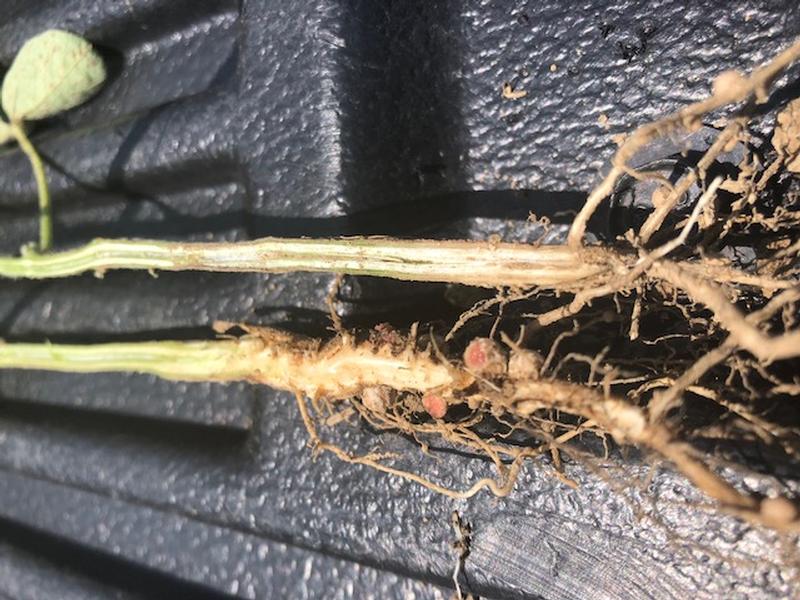
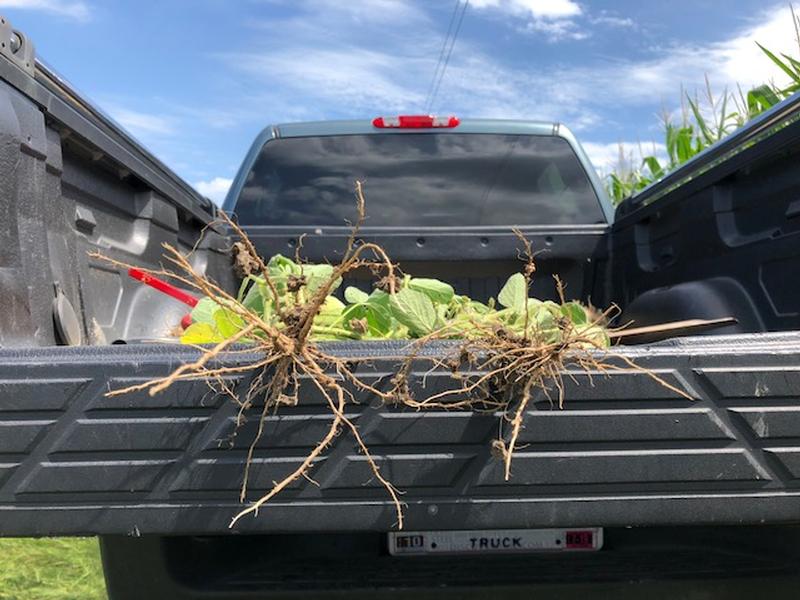
Missy Bauer from B & M Consulting provides a comprehensive discussion of soybean diseases here: https://www.agprofessional.com/article/missy-bauer-soybean-disease-watchouts
Having said all that, the soybean crop has turned a corner with this last rain and plants are adding yield. In much of the area we stand a strong chance to have both great soybean and corn yields. One last but big item to scout while walking your bean fields, will be to diligently scout for waterhemp and palmer amaranth. I previously provided information about both weeds and that we have found waterhemp in southern Putnam and northern Allen counties. I have also found waterhemp in fields along the Blanchard River, Cranberry and Riley Creeks; the seed likely flowed into the fields along with the flood waters. Farmers in these areas will want to take care so that if the plants go to seed, they do not carry seed into their other fields with the combine. Ed Lentz the Hancock County Extension Agent provided a nice article in the Findlay Courier July 31 edition. Additional information is available here from The Ohio State University http://u.osu.edu/osuweeds/super-weeds/palmer-amaranth/
The fields below are clean but in the bean field you can see waterhemp where the interplant units had not started planting, there are also waterhemp along the field edge towards the road in this field. The waterhemp in the corn field is spread throughout so this farmer will want to plan his 2019 bean program to best control the waterhemp.
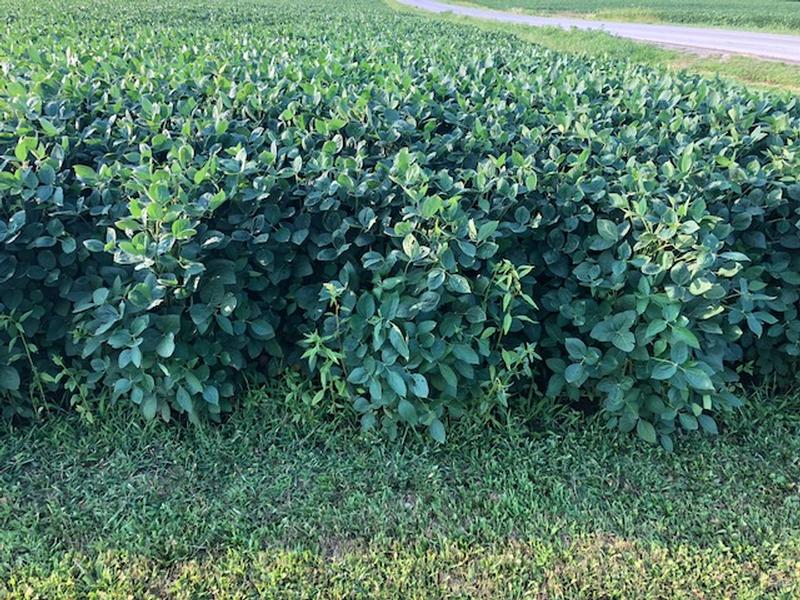
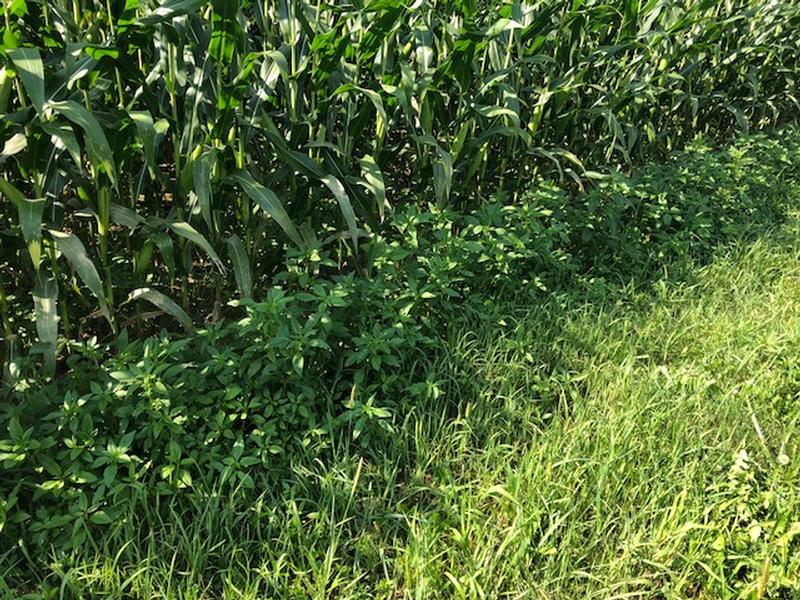
It will be very important to work to reduce weed seed carried into all your fields. It will also be important to plan for next years crop system of seed and herbicide, as you are making decisions on seed variety decisions, you are also making herbicide program decisions. The two main herbicide options for controlling waterhemp in season are Liberty and Dicamba products; both bring baggage of either poor control of Giant Ragweed or volatility for in season application. In both herbicide cases, it may be good to heed my colleagues advice and add Dual to the post-emergence application so to recharge your herbicides residual period. If planting Extend beans, it would be good to plant fields with waterhemp early so that you have a better chance of spraying the Dicamba herbicide in late May or early June before the volatility risk is so great that custom applicators do not want the liability to spray. Finding waterhemp in a field is not a terminal end for that field, but that field will require much greater management and implementation of a seed herbicide system to keep that field viable and contain the weed seed from spreading to your other fields.
July 30 2018
I would like to talk about corn and revisit the topic of Growing Degree Days and determine where we are at this season and when will we see black layer in corn. Using the tool previously mentioned on June 1, the heat unit calculator available at
https://mrcc.illinois.edu/U2U/gdd/
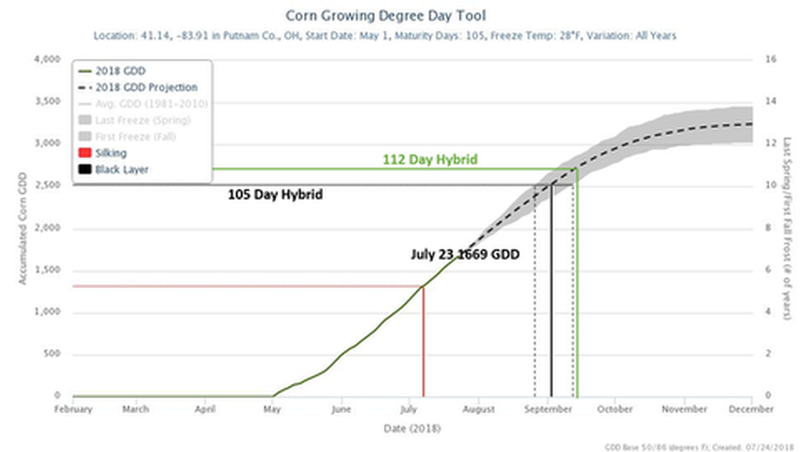
and a planting date of May 1 and on July 23 we accumulated 1669 heat units. A 105 day hybrid will need 2521 heat units to achieve black layer leaving 852 heat units needed to reach physiological maturity; this is estimated to occur on September 2. For a 112 day hybrid 2691 heat units are needed for black layer leaving 1022 heat units needed for physiological maturity; this is estimated to occur on September 12. You can use this tool to predict black layer based on your hybrid maturity and planting date.
On Monday I walked corn fields from south of Gomer to East of Leipsic; the overall crop looks good, it is starting to run short of water and in talking to local farmers there are concerns about having enough moisture for complete ear fill. As I walked fields I noticed some Northern Corn Leaf Blight, most fields the lesions are about 5% of the leaf area and below the ear with a few exceptions of 20-30% leaf damage. These next weeks will be critical for walking corn and assessing hybrid response if they were treated with fungicide. I will use the next weeks to evaluate hybrid response to the disease so that I can have a better answer than “Consider treating your racehorse hybrids”.
Most ears I pulled and counted were 14-16 kernels around and 33 kernels deep. I did observe an ear that pinched from 16 to 14 kernels around, this area was drier in late May early June and continued during ear formation.
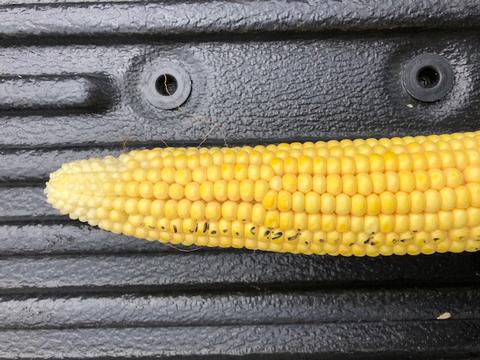
In a few fields I noticed kernel abortion with one ear demonstrating about 5% aborted kernels scattered throughout the ear; we did have high heat and some water stress this season.
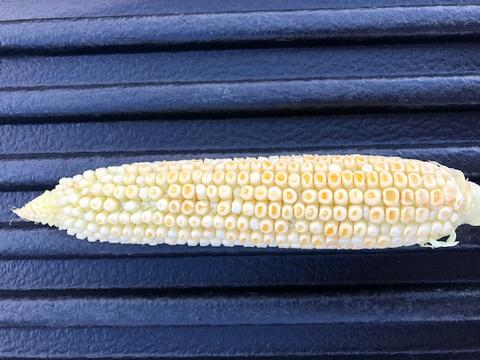
However, that may not have been the proper hybrid for that field or additional stresses like soil compaction may have been a contributing factor to these losses. I am not talking concrete level compaction but certainly yield compromising. Over these next weeks, this is the time of the season to start gathering the evidence to help you understand what compromised the yield potential of your fields. At harvest time, if you find yourself thinking that a field should have done better than it did, it will difficult to find the reasons why this happened when the only data you have is less grain in the tank. Now is the time to assess your fields to manage expectations so not to feel underwhelmed at harvest. More importantly, what you learn now will help you better prepare for improving next years crop.
July 23 2018
At Pandora Grain and Supply, our goal is to keep you informed and provide proper information to support the management decisions for your farm operation and the local environment. By this point we all are aware of the Governors recent executive order to aggressively take action towards improving the water quality of Lake Erie and the decision of the Ohio Soil and Water Commission to send the watershed decision to subcommittee.
ocj.com/2018/07/ohio-soil-and-water-commission-sends-watershed-decision-to-subcommittee/
These actions may be a preview of coming attractions of the political back and forth pinning farmers in the crosshairs and water quality as an opportunity to say “look what we did in the great state of Ohio”. There is no doubt that we all want to see a cleaner lake; I highly doubt that anyone is maliciously laughing as they are mentally preparing their cropping plans for next season. Since I started working here at Pandora Grain and Supply I have been collectively analyzing customers soil test reports to look for trends and I find that we are in line with the annual summaries for Northwest Ohio provided by A & L Great Lakes Laboratories. The data supports that we are doing a good job of managing our nutrient application rates, but these data do not inform about the sources, times, and places where nutrients are applied. Not to say we are not careful with the sources, rates, and places of application, but we need to have proper documentation saying we did what we did. When this executive order takes effect, compliance will require us to do the greatest fertilizer work ever, properly applying and documenting the right source, rate, time, and place where nutrients are applied to our farm soils.
This executive order will affect farmers by directing the state Department of Agriculture, Department of Natural Resources, and the Environmental Protection Agency to recommend rules establishing nutrient management plans for all nutrient sources. Since this executive order was issued, I attended two agriculture technology workshops where this topic was discussed along with demonstrations of fertilizer deep placement, injection, and other technologies. These technologies offer opportunities to produce our crops while complying with the new regulations, but at considerable costs. These tools may be made available through funding associated with this Executive Order. Additionally, the Tri-State Fertilizer Recommendations are being updated and these changes will be incorporated to fertility recommendations we supply with Grid Sampling. Pandora Grain and Supply has two Certified Crop Advisors on staff and staff members are seeking additional training to help you navigate these new requirements. We will help you develop these nutrient management plans and prepare documentation to follow compliance. We are happy to discuss your farming system with you and what technologies may help you comply with the Executive Order. While the political powers debate which watersheds and when they will be declared in distress, we still have a chance to demonstrate that we are capable of balancing economic and ecological production agriculture.
More information will be coming, but what can you do in the meantime?
Implement Grid Sampling and variable rate (VR) lime or fertilizer applications. Savings associated with VR lime application often cover the costs of Grid Sampling.
Adopt conservation practices like cover crops, buffer strips etc. to prevent field runoff or erosion of soil particles and nutrients. These practices are not a silver bullet, but are steps in the right direction.
Consider adopting technologies like adding guidance with RTK to your planting equipment to better utilize precision fertilizer equipment available for rent.
Consider squaring off corners or removing point rows from fields where there is considerable nutrient overlap. It is a shame to not crop on these acres, but it may be more of a shame to double apply nutrients that are not used and escape off target.
Implement field naming conventions that will help with record keeping, the Harshman farm is informative to me but provides very little information to someone helping to manage my data.
July 10 2018
Sixteen Pandora Grain and Supply customers attended the Cover Crop meeting on July 9; the group was a mix of seasoned and youthful farmers with different goals. Some attendees were looking to add diversity to their mostly soybean cropping, and others were looking to sequester nutrients for later use through mineralization.
Alan Sundermeier from the Wood County, OH extension office opened the meeting describing how farming is a system and cover crops are a valuable tool towards extending the life of this system. Most everyone in agriculture appreciates the value of organic matter and the relationship of organic matter and cover crops. Imagine two fields with the same soil textures, but one having organic matter of 2% the other having 4%; the higher organic matter is a sponge and will have more plant available water as in this figure
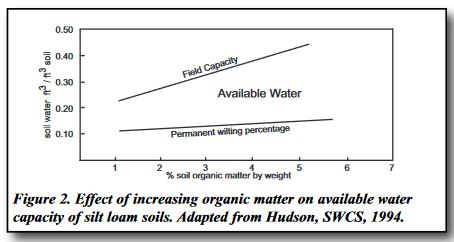
available at:https://www.nrcs.usda.gov/Internet/FSE_DOCUMENTS/nrcs142p2_053288.pdf. This is one of the many benefits of adding cover crops to your farm management system.
Alan discussed the topics of selecting cover crops for successful corn production, proper termination methods, and controlling voles in cover crop fields. As every farm and the desired goal from a cover crop cover are different, cover crop selection should be matched to each farmers management, a tool to help select cover crop species for a given management program is available here https://www.ars.usda.gov/plains-area/mandan-nd/ngprl/docs/cover-crop-chart/.
Crimping cover crops along with herbicide termination of cover crops was discussed. It is important to evaluate cash crop herbicide persistence and possible restrictions for planting cover crops; useful information is available here http://blog.uvm.edu/cvcrops/files/2012/09/Cover_crop_and_herbicides.pdf.
The last topic was control of voles which is somewhat difficult as some of the beneficial aspects of cover crops may also provide a robust environment for voles. Information is available here https://www.nrcs.usda.gov/Internet/FSE_DOCUMENTS/stelprdb1251776.pdf and cover crop management strategies are available to reduce losses to this pest.
A representative of LaCrosse seed provided additional information and recommended seed offerings to match farm management strategies. Contact your Pandora Grain and Supply Sales associate or Agronomist for additional information if you are interested in adding cover crops to your farm management program.
June 28 2018
Anticipated heat Stress on Corn
As we enter into the weekend of June 30 with very high heat predictions and corn fields around Pandora are likely to start tasseling early next week, there may be concern about how this may compromise your corn yields this fall. Fortunately, the overall health and plant available water in the region are very good, the excellent planting conditions we had this spring provided a foundation for the crop to withstand the anticipated heat this weekend. With the ample soil water and only a short window of predicted temperatures above 90 degrees the corn crop will enter into pollination with little to no yield losses from the heat. R1 or silking following tassel emergence is the period of greatest water demand by the corn plant and heat stresses of four days in this period may reduce yields by 1%, five days yield may be reduced an additional 2%. Iowa State Research available at:
https://crops.extension.iastate.edu/cropnews/2011/07/corn-and-big-long-heat-wave-way
Remember that corn is originally a tropical grass originated from the mountains of central Mexico where it was adapted to warm daytime (above 86 oF) and cool nighttime (below 70 oF) temperatures. Daytime temperatures above 86 oF will make the corn plants uncomfortable but corn is adapted to cope with the heat. The nighttime temperatures this weekend are predicted in the lower 70s and that will increase dark respiration in the corn but not at rates that will significantly compromise yields. During this weekend of high temperatures, worry more about hydrating and protecting yourself from the heat than your corn crop.
June 26 2018
Preparing for in season fungicide applications
In a recent blog article from the University of Illinois “Tips to help you make fungicide decisions” found here http://cropdisease.cropsciences.illinois.edu/?p=743 Nathan Kleczewski provides key points to help in deciding to spray (or not) fungicides:
· Fungal diseases only occur when the correct pathogen, plant host, and environment occur together
· The amount of disease is related to the duration of time conditions for disease are met
· Not all disease results in yield loss
· Fungicides minimize fungal disease
· Economic returns are greatest when fungicides are applied to susceptible plants and conditions favoring disease occur.
As we all know we have had extremely variable and sometimes very heavy rainfall in Northwest Ohio; disease pressure may not be uniform and decisions will be made farm by farm rather than across the region. If this pattern continues wet fields could persist into the fall, overall plant health including stalk integrity may become more of an issue at harvest. We typically measure fungicide efficacy by grain yield, but if fungicide application results in improved plant health and standability at harvest allowing easier/faster harvest, saving time and reducing stress at harvest may be incidental benefits of treating fields. In season commodity prices have changed and may cause farmers that typically spray to reconsider decisions. Conversely, farmers that have not historically sprayed may consider spraying to protect their investment of a good looking corn crop. These management decisions will be different for all farm managers. Regardless, Pandora Grain is prepared to help you with these decisions. We have aerial application services retained for fungicide applications, reach out to your sales advisor for additional help in protecting your 2018 crop.
June 15 2018
It is time for diligent weed scouting.
As you are scouting your fields be on the lookout for Waterhemp and Palmer Amaranth. We have identified Waterhemp in Allen county this season and are working to control this problematic weed.
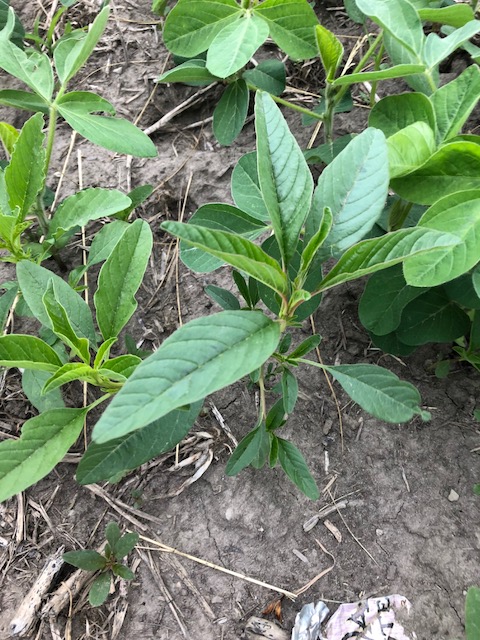
Additional resources are available from The Ohio State University at
http://u.osu.edu/osuweeds/super-weeds/palmer-amaranth/
Controlling these weeds requires a systems approach including diligent scouting throughout the season, possibly tillage, applying herbicides with a residual, and stacking multiple herbicide modes of action. Obviously controlling the weeds early in the season will help the 2018 season. Controlling these weeds will be realistic if Liberty or Dicamba resistant beans were planted. If these weeds are found in conventional or Glyphosate only resistant beans herbicide options become limited and a control strategy of containment becomes more realistic so not to spread seed from these weeds to other fields to further spread the problem. In the case of Palmer amaranth, contact Dr. Mark Loux at loux.1@osu.edu or call (614)292-9081 to report an infestation. Also contact your Pandora Grain sales representative if you find these weeds in your field and we will work with you to provide products to limit the effects of these weeds. It is more important to control these weeds in the first quarter than punt in the fourth; a systems approach of diligent scouting, stacking herbicide modes of action, and limiting spread will lessen the risk of these weeds compromising your farming success.
June 1 2018
With over 80% of the Ohio corn crop planted and 65% emerged, farmers can be thinking about the next milestones for the 2018 corn crop. Most of the local crop was planted well and side dressing is winding down; the stage is being set for good yields. When evaluating this crop, one tool that may help in decision making on this and future crops is a Growing Degree Day (GDD) calculator provided by the High Plains Regional Climate Center https://hprcc.unl.edu/gdd.php#
Here is an example of April 23 planting date of a 111 day RM hybrid planted in Putnam County Ohio. Based on 30 year data, the estimated silk date for this hybrid is July 20 and estimated black layer (physiological maturity) is September 24. The years 2015-2017 are included for comparison. This tool can be accessed at https://hprcc.unl.edu/gdd.php# and I encourage you to input your planting dates and hybrid maturities and compare to the progress of your corn crop.
Additional interesting things you may evaluate:
· Compare planting dates when we have spring rains causing two planting seasons.
· Pick years that were extremes: wet, dry, or wet spring then dry summer.
· See if there is a change in GDD accumulation from 1981 till now.
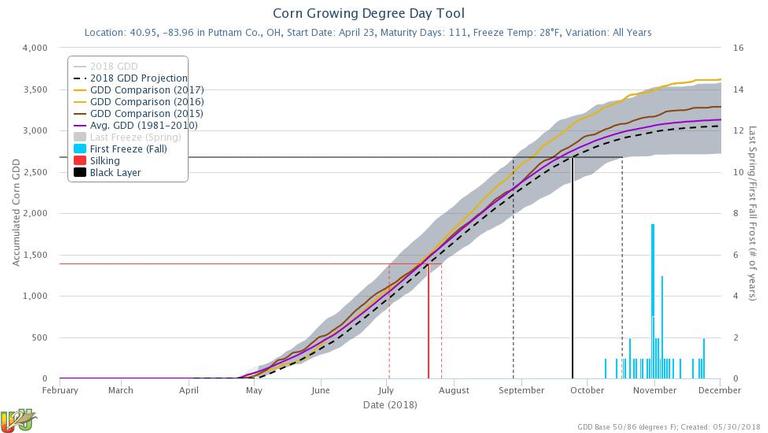
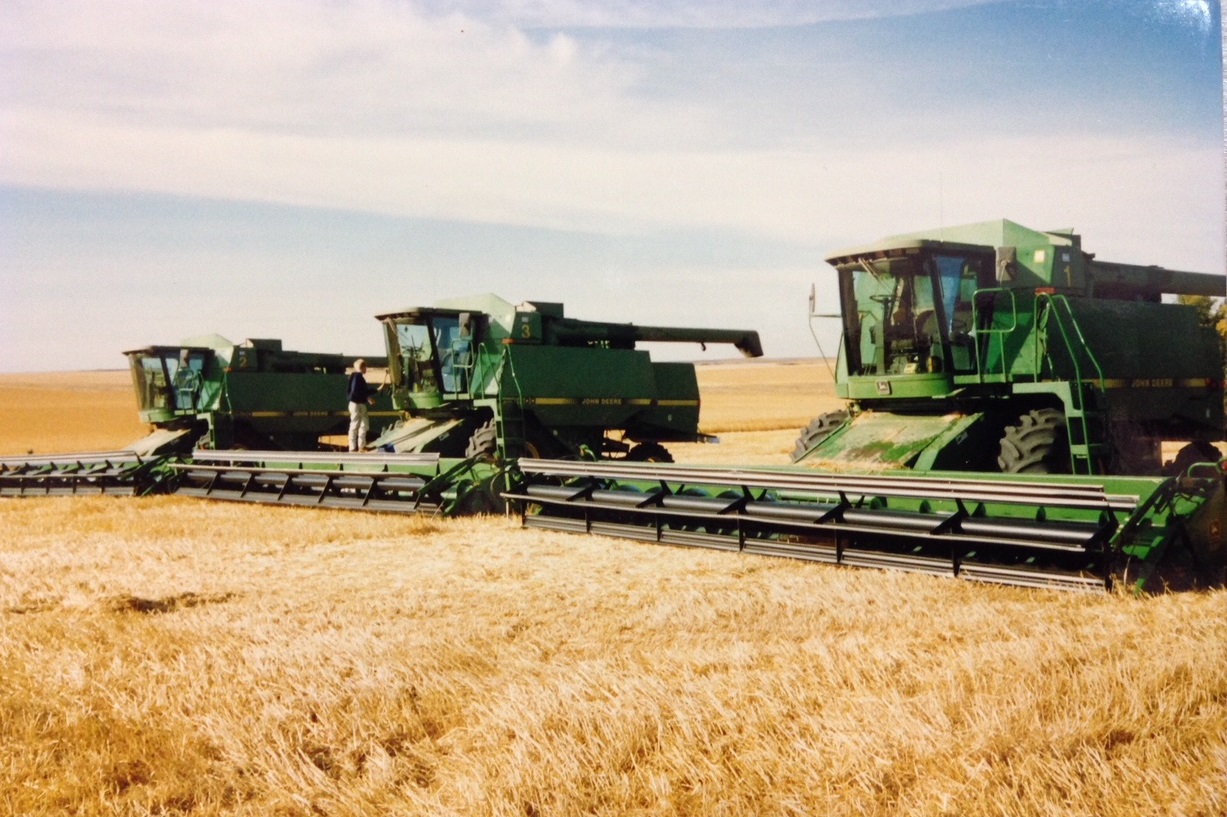
|
|

